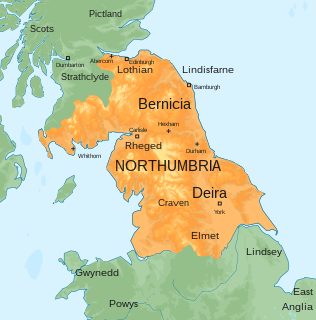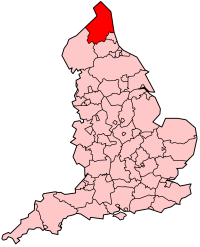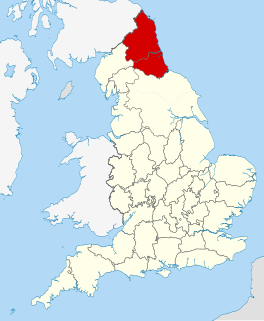Northumbria was an Anglo-Saxon kingdom in early medieval England.
Contents
Northumbria or Northumbrian may also refer to:
Northumbria was an Anglo-Saxon kingdom in early medieval England.
Northumbria or Northumbrian may also refer to:

Northumbria was an early medieval Anglo-Saxon kingdom in what is now Northern England and south-east Scotland.

Northumberland is a county in Northern England, one of two counties in England which border with Scotland. Notable landmarks in the county include Alnwick Castle, Bamburgh Castle, Hadrian's Wall and Hexham Abbey.
Pitmatic is a traditional English dialect spoken in the Northumberland and Durham Coalfield in England.

Berwick-upon-Tweed, sometimes known as Berwick-on-Tweed or simply Berwick, is a town and civil parish in Northumberland, England. Located 2+1⁄2 mi (4 km) south of the Anglo-Scottish border, it is the northernmost town in England. The 2011 United Kingdom census recorded Berwick's population as 12,043.
Northumbrian may refer to:
Northumberland is a ceremonial county and unitary authority area in North East England.

Northumberland, England's northernmost county, is a land where Roman occupiers once guarded a walled frontier, Anglian invaders fought with Celtic natives, and Norman lords built castles to suppress rebellion and defend a contested border with Scotland. The present-day county is a vestige of an independent kingdom that once stretched from Edinburgh to the Humber, hence its name, meaning literally 'north of the Humber'. Reflecting its tumultuous past, Northumberland has more castles than any other county in England, and the greatest number of recognised battle sites. Once an economically important region that supplied much of the coal that powered the industrial revolution, Northumberland is now a primarily rural county with a small and gradually shrinking population.
Here Northumbria is defined as Northumberland, the northernmost county of England, and County Durham. According to 'World Music: The Rough Guide', "nowhere is the English living tradition more in evidence than the border lands of Northumbria, the one part of England to rival the counties of the west of Ireland for a rich unbroken tradition. The region is particularly noted for its tradition of border ballads, the Northumbrian smallpipes and also a strong fiddle tradition in the region that was already well established in the 1690s. Northumbrian music is characterised by considerable influence from other regions, particularly southern Scotland and other parts of the north of England, as well as Irish immigrants.
Northumbrian was a dialect of Old English spoken in the Anglian Kingdom of Northumbria. Together with Mercian, Kentish and West Saxon, it forms one of the sub-categories of Old English devised and employed by modern scholars.

Northumbria Police is a territorial police force in England. It is responsible for policing the metropolitan boroughs of Newcastle upon Tyne, Gateshead, North Tyneside, South Tyneside and the City of Sunderland, as well as the ceremonial county of Northumberland. It is the largest police force in the North East by geographical area and number of officers. The force covers an area of 2,141 square miles (5,550 km2) with a population of 1.46 million.

The English language in Northern England has been shaped by the region's history of settlement and migration, and today encompasses a group of related dialects known as Northern England English. The strongest influence on the modern varieties of the English language spoken in Northern England is the Northumbrian dialect of Middle English, but also contact with Old Norse during the Viking Age, with Irish English following the Great Famine and particularly in Lancashire and the south of Yorkshire, with midlands dialects since the industrial revolution, have produced new and distinctive styles of speech. Some "Northern" traits can be found further south than others: only conservative Northumbrian dialects retain the pre-Great Vowel Shift pronunciation of words such as town, but all northern accents lack the FOOT–STRUT split, and this trait extends a significant distance into the Midlands.
This timeline summarises significant events in the history of Northumbria and Northumberland.

The Northumbrian dialect refers to any of several English language varieties spoken in the traditional English region of Northumbria, which includes most of the North East England government region. The traditional Northumbrian dialect is a moribund older form of the dialect spoken in the area which is closely related to Scots and Cumbrian and shares with them a common origin in Northumbrian Old English. However, some consider the Northumbrian dialect a language, citing its lack of mutual intelligibility with Standard English as well as its similarity with Scots.

The Northumbrian burr is the distinctive uvular pronunciation of R in the traditional dialects of Northumberland, Tyneside ('Geordie'), and northern County Durham, now remaining only among some older speakers of rural Northumberland.
Rhymes of Northern Bards is a book of North East England traditional and popular song consisting of approximately 200 song lyrics on over 300 pages, published in 1812. It was reprinted in 1971 by Frank Graham, Newcastle upon Tyne with an introduction by David Harker.
John Stokoe was a 19th-century Tyneside author and historian. He co-operated with the author John Collingwood Bruce in compiling the hugely important “Northumbrian Minstrelsy” published in 1882.
Northumbrian Minstrelsy is a book of 18th and 19th century North East of England folk songs and pipe music, intended to be a lasting historical record. The book was edited by John Stokoe and the Rev John Collingwood Bruce LL.D., F.S.A., and published by and on behalf of the Society of Antiquaries of Newcastle upon Tyne in 1882. It was reprinted in 1965 by Folklore Associates, Hatboro, Pennsyslvania, with a foreword by A. L. Lloyd.

The Army Riding School was a military installation in Northumberland Road, Newcastle upon Tyne.

In modern contexts Northumbria usually refers to the region of England between the Tees and Tweed, including to the historic counties of Northumberland and Durham, but may also be taken to be synonymous with North East England. The area corresponds to the rump lands of the historical Kingdom of Northumbria, which later developed into the late medieval county of Northumberland or Comitatus Northumbriae, whose original southern boundary was the River Tees. A representative provincial flag of Northumbria is registered for the area.